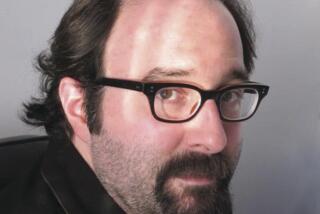THE WAY WE WATCHED
- Share via
1893--The Brooklyn Institute physics department witnesses Thomas Edison’s Kinetograph. An optical lantern projector, it shows moving images of a blacksmith and his helpers forging a piece of iron.
*
1895--Edison exhibits hand-colored movies, including “Annabelle, the Dancer,” at the Cotton States Exhibition in Atlanta.
*
1896--Paying moviegoers watch Edison’s Vitascope project a ballet sequence at the Koster and Bial’s Music Hall in New York.
*
1902--The 200-seat Electric Theater opens in downtown Los Angeles, charging patrons of the cinema a dime.
*
1922--An adventure, “The Toll of the Sea,” gives viewers a crude notion of what Technicolor will bring.
*
1926--”Don Juan,” starring John Barrymore, is released with Vitaphone (sound synchronized with disc phonograph records) music and sound effects.
*
1927--The talkie speaks. “The Jazz Singer” stars Al Jolson, who performs musical numbers and even speaks.
*
1927--Sid Grauman’s palatial Chinese Theatre opens in Hollywood, with Cecil B. DeMille’s “King of Kings” screening for 2,000 viewers.
*
Late ‘20s--David Wallerstein, a manager with Balaban & Katz theaters in Chicago, introduces buttered popcorn as a moviegoing snack.
*
1929--Transcontinental Air Transport shows a newsreel and two cartoon comedies 5,000 feet up. Regular in-flight screenings begin 32 years later on TWA with the melodrama “By Love Possessed.”
*
1930--”The Big Trail,” starring newcomer John Wayne, is shot in a wide-screen process called Grandeur. The film flops and so does Grandeur.
*
1933--With 6,200 seats, New York’s Radio City Music Hall surpasses Paris’ Gaumont Palace as the world’s biggest movie theater. More important, the Rockettes entertain before the show.
*
1934--”Sit in your car . . .” So begins the instructions to spectators at Los Angeles’ first drive-in, at Pico and Westwood boulevards in Los Angeles.
*
1935--Technicolor gets better with “Becky Sharp.”
*
1939--James Edwards Sr., founder of the Newport Beach-based Edwards Theatres, creates the multiplex when he guts a grocery store to erect a second screen next to his movie house in Alhambra. (Stan Durwood of AMC Entertainment will later claim he’s the father of the multiplex for opening side-by-side theaters in Kansas City, Mo.)
*
1940--”Fantasia” is released in stereo sound.
*
1944--A two-reel short, “Patrolling the Ether,” airs on television, 12 days before MGM releases it in theaters.
*
1952--Anxious to attract the progenitors of couch potatoes, Hollywood releases its first 3-D feature, “Bwana Devil.” (Its director, Arch Oboler, had only one eye and couldn’t even appreciate the 3-D visuals.)
*
1952--The travelogue “This Is Cinerama” introduces a big-screen concept, involving multiple cameras and projectors, that ultimately goes nowhere.
*
1953--”Forever Female” is shown simultaneously in a movie theater and on 70 Telemeter (pay TV) sets, all in Palm Springs.
*
1959--William Castle’s horror film “The Tingler” offers two new gimmicks: 1) bloodcurdling screams on screen that trigger a jolt of electricity through the seats 2) human plants in the audience who scream and seem to pass out.
*
1959--”Behind the Great Wall,” a travelogue of modern China, presents not only the sights and sounds of the country, but also the smells. Scents arrive via ceiling vents, thanks to the Aromarama process.
*
1963--Cinerama Dome in Hollywood unveils a nearly 90-foot-wide screen--the world’s largest at the time.
*
1967--The buzz surrounding multiscreen films at EXPO ’67 in Montreal gives the unborn IMAX giant-screen system a push. Toronto gets the first permanent IMAX projection system in 1971, two years before the IMAX “Dome” premieres at the Reuben H. Fleet Space Theatre in San Diego.
*
1974--”Sensurround” debuts with “Earthquake.” The seats shake. Still, Universal’s subgenre peters out after “Midway” and “Rollercoaster.”
*
1974--The Z Channel, targeting film buffs with an eclectic mix of commercial hits, vintage and foreign films, is launched in Los Angeles.
*
1975--Sony produces the first videocassette recorder, the Betamax.
*
1977--”Star Wars” features Dolby stereo.
*
1981--Fans play along with John Waters’ “Polyester,” scratching and sniffing Odorama cards as numbers appear in the corner of the screen.
*
1985--A bitterly fought colorized version of “It’s a Wonderful Life” hits video stores.
*
1987--”Million Dollar Mystery” offers a cool million to the moviegoer who guesses where the film’s hidden loot is stashed. Though there is a winner, the costly film dies quickly at the box office.
*
1993--”Wax: Or the Discovery of Television Among the Bees,” a science-fiction film directed by David Blair, is broadcast on the Internet.
*
1997--The digital video disc (DVD) features crisp pictures, a longer shelf life than a video and a plethora of interactive extras.
More to Read
The biggest entertainment stories
Get our big stories about Hollywood, film, television, music, arts, culture and more right in your inbox as soon as they publish.
You may occasionally receive promotional content from the Los Angeles Times.











